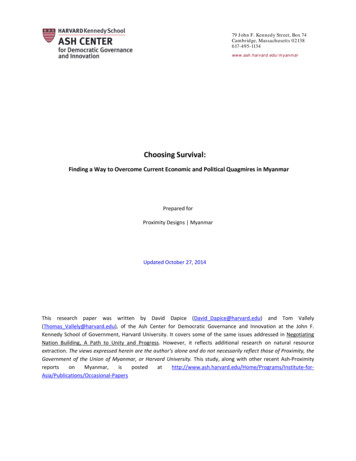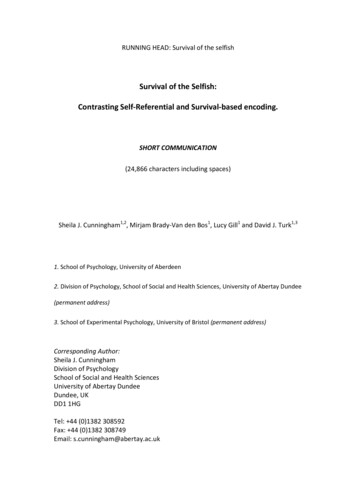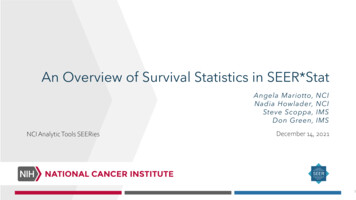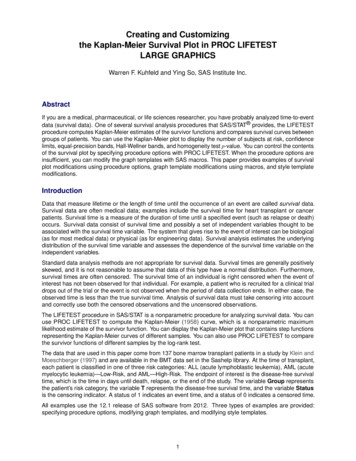
Transcription
79 John F. Kennedy Street, Box 74Cambridge, Massachusetts ng Survival:Finding a Way to Overcome Current Economic and Political Quagmires in MyanmarPrepared forProximity Designs MyanmarUpdated October 27, 2014This research paper was written by David Dapice (David Dapice@harvard.edu) and Tom Vallely(Thomas Vallely@harvard.edu), of the Ash Center for Democratic Governance and Innovation at the John F.Kennedy School of Government, Harvard University. It covers some of the same issues addressed in NegotiatingNation Building, A Path to Unity and Progress. However, it reflects additional research on natural resourceextraction. The views expressed herein are the author’s alone and do not necessarily reflect those of Proximity, theGovernment of the Union of Myanmar, or Harvard University. This study, along with other recent ublications/Occasional-Papers
ContentsBackground . 5Past Levels of Performance. 7Ethnic and Religious Violence . 11Current Economic Progress. 12Land and Agriculture . 13Exchange Rates and Finance . 13Proposed Solutions . 14List of Boxes and GraphsGraph 1: The Acemoglu and Robinson Paradigm . 5Box 1: A Note to Those Who Dislike Federalism. 6Graph 2: GDP per capita at real for selected Asian countries over 32 years . 7Graph 3: Change in kWh per capita, 1990-2010 . 8Graph 4: Sum of 2011 World Bank Governance Indicators . 9Graph 5: 2012 UNDP Human Development Index. 10Graph 6: Reported GDP Growth vs. Official Growth in Electricity and Trade from 2011/12 to 2012/13 . 12Graph 7: Partners in Nation Building . 17Graph 8: Southeast Asia: The Importance of Resource Based Industries . 19
Choosing Survival: Finding a Way to Overcome Current Economic and Political QuagmiresUpdated October 2014Page 5 of 21BackgroundMyanmar faces a choice between maintaining some version of the status quo in which the military holdssway while allowing some limited forms of democracy or creating a genuine shift to a more open andinclusive system. This is not just a choice about who gets what share of the national output or even howfast that output grows, though that is part of the choice. The main choice is between national survivaland unity or weakness and division. Myanmar may end up more like Pakistan than Indonesia. 1 To avoidthis, it needs a broad coalition of interest groups that support federalism, resource sharing, and taxationof resources for productive public investment. Such a change requires a fairly elected government and astronger rule of law, including protection of minorities and those with wealth, however acquired. Thecurrent path is producing religious tension, limited sustainable growth (in spite of good intentions andhigh reported GDP growth), and ethnic and religious conflicts. The following graphic summarizing WhyNations Fail, a recent book, illustrates the situation 2. However, Myanmar is leaning to the left side of thediagram – closer to failure than success.1Pakistan is a country in which the military retain a large role in many aspects of governing, including the economy. It hasexperienced slow (2.7% per capita GDP) growth since 1990, an insurgency, and much corruption. In Indonesia there is fastergrowth, a “normal” role for the military, and peaceful and democratic elections. The sum of governance indicators for Pakistanin 2013 is 113 (lower than Bangladesh); Indonesia is 263, higher than Vietnam.2The Acemoglu-Robinson argument works well for middle income countries needing to sustain growth that have “outgrown”the authoritarian regimes that got them started. It also may work for poorer nations that have found authoritarian regimes tobe failures. Because of Myanmar’s specific historical experiences, we believe that this paradigm applies to their currentsituation. Ironically, this historical approach runs counter to the claims of universality of Acemoglu and Robinson.
Choosing Survival: Finding a Way to Overcome Current Economic and Political QuagmiresUpdated October 2014Page 6 of 21There has been much upbeat commentary about Myanmar, seeking to beat the drum for a newemerging market. Long years of political isolation from all but some Asian countries have meant verylow levels of western investment. There is no doubt that western aid and investment levels will rise, butit is crucial to understand where Myanmar is starting from. It is not just poor; it is still partly dominatedby the military. It has never been a peaceful, united nation. There has been no normal system of publicfinance. Basic structures of government have atrophied as the military has displaced almost every othergroup, aside from their business associates. Negotiations to end civil conflict in the ethnic areas areundermined by major offensives. Endemic religious violence appears to be instigated by those whocalculate the disturbances work to their advantage. These are dangerous trends that are derailing theprocess of nation building and successful development. If the current situation of decisive militaryinfluence and extraction persists, the chances for economic and political success are low and eveneffective national survival is in question. A choice to direct huge mineral resources to nationaldevelopment is needed – and this can only be accomplished by a broad coalition supporting federalism.Box One: A Note to Those Who Dislike FederalismThe Army has fought for over a half century to keep Burma and then Myanmar united.It has seen federalism as separatism, the division of the nation. Even using the wordcauses many to question the legitimacy of the speaker or writer. The argument in thispaper is that a type of negotiated federalism – in which the army is a partner to thenegotiations – is necessary for the survival of Myanmar as an independent nation.Either the nation stays in tension and conflict and is gradually dominated or it becomesa developmental state and grows stronger. If natural resources are used for military orprivate ends rather than nation building, the results will be poverty, instability and aneffective loss of national sovereignty. The Army has to become smaller as peace takesroot, but also more professional and capable. A scholar and friend and resident ofBurma, Professor J.S. Furnivall, wrote in 1931: “If as is but too probable, the obstaclesprove insurmountable [it] can only be a matter of time and, after a period of anarchymore or less prolonged, our descendents may find Burma a province of China. Chinahas a great civilization and it is quite possible that the absorption of Burma by theChinese will be the best destiny for the Burmese.” (An Introduction to the PoliticalEconomy of Burma, page xxiv.) Giving some local autonomy and share of resourcerevenues to fairly elected governments in ethnic states (or divisions) is the only way tokeep the nation intact and independent. The successful decentralization of Indonesiawith its own regional pressures shows this is not just academic speculation.This paper lays out the facts about where Myanmar has been, where it is, and what kinds of changes areneeded to create conditions for unity, peace and inclusive and sustainable development. While theanalysis in this paper is cautionary and often negative, its purpose is to solve problems, not complain.Creating a coalition for nation building will be easier if the poor current situation is better understood.
Choosing Survival: Finding a Way to Overcome Current Economic and Political QuagmiresUpdated October 2014Page 7 of 21Achieving the desired goals will not be easy and will likely take longer than many understand or imagine.Avoiding narrow coalitions that would continue current extractive policies is necessary to move forward.However, a feasible path exists and many current government policies are meant to put the nation onthat path. This paper aims to contribute to those efforts and build on the progress already made.Past Levels of PerformanceGNI Per Capita (PPP), in real for selected Asian Economies Over 23 20002013Alternate 2013: IMFThis series takes the World Bank estimates of PPP GNI per capita in 1990, 2000, and 2013 for most nations. Since no World BankGNI estimate is available for Myanmar, data for 2013 is a CIA estimate of PPP GDP, and earlier years are Harvard estimatesbased on electricity consumption. IMF data for 2013 are shown in the “Alternate 2013” year.This graph shows per capita GNI in purchasing power parity (equivalent international price terms) forselected Asian nations since 1990. Myanmar – the bottom black line – has grown, but very slowly. ItsPPP GDP per capita in 2013 was 1700 according to the CIA. The CIA is used because the World Bankmade no estimate. (The final dotted lines show IMF estimates of PPP 2013 GDP per capita – theirestimate puts Myanmar nearly equal to Vietnam even though electricity consumption per capita inVietnam was nearly seven times that of Myanmar.) The World Bank did estimate that Indonesia’s PPP2013 gross income (a closely related concept) was 9260. Since Myanmar (then Burma) was richer thanIndonesia in 1960 3, it is clear that the last decades have been ones of very modest progress. Anotherway of showing this is to graph the change in electricity consumption per capita since 1990, asillustrated in the graph on the following page. This shows the increase in total electricity sales divided bypopulation from 1990 to 2013.3Economic Development and Cultural Change, Volume 18, number 1, part II, October 1969, p. 20 shows Burmawith 1960 per capita GDP of 66 and Indonesia with 63. Indonesia is now several times as rich as Myanmar usingPPP rather than exchange rate based estimates, which are the estimates cited for 1960. The IMF recently putMyanmar’s PPP GDP per capita at 4345, close to that of Vietnam which has six times as much kWh per capita.
Choosing Survival: Finding a Way to Overcome Current Economic and Political QuagmiresUpdated October 2014Page 8 of 2123 Years of Growth – Change in kWh per capita, 1990-2013Source: World Bank On-line Data Base, consumption of electricity per capita in kWh and ADB Key Indicators.It is noteworthy that Bangladesh is one of the poorer nations in Asia and Indonesia is notorious for itsunderinvestment in power and infrastructure. Even so, the change in per capita electricity was greater inBangladesh than in Myanmar while Indonesia gained seven times as much. This measure avoids many ofthe data problems that bedevil attempts to estimate GDP per capita.One reason for this underperformance is that the past governments in Myanmar were extractive andplaced a low priority on funding even basic infrastructure, much less health or education. 4 This waspossible in part because economic data were often falsified and partly believed – economic growth ratesof 12% a year were regularly recorded even when electricity per capita barely grew and rice per capitaoutput was falling. World Bank governance indicators provide a useful measure of Myanmar’s level ofgovernmental functioning. These are six dimensions of governance measured in percentiles 5, so amaximum score would be 600. As the graph shows, Myanmar scored 52 out of 600 in 2013 – similar tothe North Korean governance score. Rapid growth with this very low level of governance is all butimpossible since uncertainty deters investment. 64This underinvestment is being corrected as gas revenues are finally collected at a reasonable exchange rate, but tax revenuesfrom other minerals are still well below levels typical in other nations.5The six types of governance are 1. Voice and accountability; 2. Political stability and absence of violence; 3.Governmenteffectiveness; 4. Regulatory quality; 5. Rule of law; and 6. Control of corruption.6Quality investors want a level playing field, clear rules, security against confiscation and a government that is more like a fairreferee than another player seeking to drain their business of revenues. Crony investors want the opposite – special favors andexclusion of competitors, even if it means sharing revenues with those making and enforcing the rules.
Choosing Survival: Finding a Way to Overcome Current Economic and Political QuagmiresUpdated October 2014Page 9 of 21Sum of World Bank Governance Indicators:Myanmar is the second lowest in AsiaGovernance Score in 2013400350300250200150100500North landMalaysiaSince 1996, the World Bank has rated most nations on six dimensions of governance: voice andaccountability; stability and absence of violence; quality of regulation; governmental capacity; rule of lawand control of corruption. A maximum summary score would be 600.http://info.worldbank.org/governance/wgi/mc countries.aspWhile budget data have been mostly secret and are still not fully disclosed, the World DevelopmentIndicators 2012 report total health care spending in 2010 was 2% of GDP and only an eighth of that waspublically funded – a mere 0.25% of GDP. Bangladesh spent 3.5% of GDP on health and public spendingcovered one-third of that, or 1.2% of GDP. (Cambodia is higher still.) Myanmar’s share of public healthspending is among the lowest in the world. Similar recent data for educational spending are notavailable, but in 1999, only 6.6% of GDP per capita was spent on a secondary school student. Bangladeshand Cambodia then had about 12%. Things since then have not improved much if at all, so it is safe toconclude that public spending on health and education is among the lowest in Asia and possibly in theworld. 7 Certainly the sporadic shutting down of the universities has severely depleted the supply ofskilled workers and managers. The graph below shows the UNDP calculated Human Development Indexfor 2013. This is an index that reflects levels of education, health and income per capita. Myanmar islower than Bangladesh and Cambodia in stark comparison to a period after World War II when it wasamong the most educated nations in the region. Even worse, many of the most educated have leftMyanmar and the composition of the workforce reflects both the past decades of underinvestment andthe migration of educated workers to neighboring and more distant nations.7A recent sampling of some rural areas with a functional literacy test found that about half of rural adults could answer allthree simple questions correctly when the answers were clearly written and in front of them. This was not a national samplebut suggests that official literacy data, with more than 90% literacy, may be overstated.
Choosing Survival: Finding a Way to Overcome Current Economic and Political QuagmiresUpdated October 2014Page 10 of 212013 UNDP Human Development Index0.80.70.60.50.40.30.20.10The miserable governance in the recent past, lack of electricity and failure to train the work force has ledto minimal levels of foreign direct investment. According to the 2014 World Investment Report byUNCTAD, Myanmar had only 278 per capita in its stock of FDI, mostly for raw materials. Cambodia hadmore than twice as much and Vietnam more than three times. Even landlocked Laos had 60% more FDIper capita. Japan, which sees itself vying with China for influence in Myanmar, has been boosting its aidlevels but Japanese businesses have been reluctant to invest in Myanmar even as they exit China insearch of alternatives. 8 The major exceptions have been natural resource investments, or perhaps somein tourism and real estate.There has been massive government mal-investment and underinvestment. Billions of dollars werespent on Nay Pyi Taw (which itself is questionable), but the road to the new capital from both Yangonand Mandalay did not use reinforced steel rods, so trucks cannot use the road. This greatly diminishesthe economic value of that investment. Regulations kept cell phones so expensive that Myanmar laggedbehind Africa. The cell phone situation is improving, but mobile coverage in 2012 was still only 11 per100, compared to 64 per 100 in Bangladesh.9 Internet use in 2012 was 1 per 100 people. Trucking costsare five to ten times higher per ton-kilometer than in Thailand or China according to surveys by Harvardresearchers. Except for natural resources and 700 million of garments 10, there is little export activity. Inshort, the country lags well behind its neighbors in almost every relevant dimension.8The amount of licensed (not realized) FDI from 1988 to July 2012 was 43 billion, largely from Asia excluding Japan. Chinaincluding Hong Kong alone accounted for 48% of that total and Thailand for 23%.9Data from: default.aspx10While garment exports have risen in recent years, Cambodia in 2012 had garment exports of 307 per capita while Myanmarin 2012/13 had less than 12.
Choosing Survival: Finding a Way to Overcome Current Economic and Political QuagmiresUpdated October 2014Page 11 of 21Ethnic and Religious ViolenceIt is perhaps not surprising that in a country where income is so concentrated and widespread progressso limited, there has been conflict. The long-running ethnic conflict, going on and off since the 1950’s,appeared last year to be drawing to a close except in Kachin state where over 100 battalions fought theKachin Independence Army over jade and trade routes in spite of movement toward a national ceasefire This has created 100,000 internally displaced people and resulted in dozens of villages beingdestroyed. Recently conflict has spread to the Shan state as well. The threat of land seizures alsopersists 11. The cease fires, first negotiated in the 1990’s, basically allowed the Burmese Army and thearmed ethnic groups to unevenly split the resource rents, smuggling, drug profits, and road tolls andother “contributions” but held back any real progress in the ethnic states. The lack of economic progressand threat of violence contributed to the millions of workers who moved to Thailand and other nations.Many of these are skilled workers (Singapore is said to have over 40 thousand engineers from Myanmar)and labor shortages are reported in some of these ethnic states, even where it is peaceful. If the“solution” to this conflict is an imposed peace with continued extraction, it would be a huge negative fordevelopment and national unity. Such an imposed settlement would result in continued economicstagnation (except for continued resource extraction) and migration. A nation does not thrive when itsyoung people leave.In addition to the ethnic conflicts there has been a recent upsurge in anti-Muslim violence. At first thiswas largely confined to Rakhine state next to Bangladesh where radical Buddhist monks suggested withlittle evidence that there had been uncontrolled migration and rapid population growth among Muslimsdue to multiple wives, large numbers of children, and conversions. 12 One monk in particular, AshinWirathu, had been jailed for his inflammatory preaching but was released after the 2007 suppression ofthe Buddhist monks by the military government. He is now the head of a large monastery and enjoystacit government support. 13 Muslims account for only 5% or so of the population. (Historical recordsshow that the ratio declined from 1881 to 1983; a new census has been conducted and should providemore reliable data in 2015.) Conditions have not improved in Myanmar relative to Bangladesh sincethen – indeed by 1989 Bangladesh consumed more electricity per capita than Myanmar and morerecent surveys show levels of living in Bangladesh much better than those in Rakhine. Organizedviolence with little official protection or subsequent prosecution suggests that at least some elements ofthe security forces allow or support these actions. It goes without saying that systematic persecutioncould attract international jihadi attention. This is not what the tourist industry, bridges, pipelines orpower stations need. In addition, the threat of violence against minorities, especially in Rakhine state,threatens the very idea of democratic federalism. This is not only a threat to the peace and prosperity of11The military and government are still taking land throughout the nation, often with few legal niceties. 9/myanmar-s-land-grab-problem12Indeed, the 1978 “King Dragon” operation under Ne Win had produced a flow of 250 thousand Muslim refugees toBangladesh, contributing to a net outflow of migrants to India and Pakistan.13Violence in 2014 even drove out the UN and international groups staffing refugee camps for Muslims in Rakhine.
Choosing Survival: Finding a Way to Overcome Current Economic and Political QuagmiresUpdated October 2014Page 12 of 21Rakhine; it is also a threat to nation building, ethnic reconciliation and democracy. How can there be asafely reduced role for the security forces if violence results?Current Economic ProgressA reasonable retort might be that as bad as things were in the past, the present is much brighter. Forexample, the IMF estimated real GDP growth of 16% from 2011/12 to 2013/14. 14 That estimate of nmentdata:(Source:https://www.mnped.gov.mm/ )Estimated Growth in GDP, Electricity, and Tradefrom 2011/12to ityExports in Imports in Sources: GDP from IMF; Electricity, Imports and Exports from Official Myanmar data from the Central Statistical Organization, MyanmarMinistry of National Planning and Economic Development, online at https://www.mnped.gov.mmThe welcome gains in electricity (12% a year for two years) will be difficult to maintain due to a lack ofsubstantial new hydroelectricity or gas supplies for several years. Likewise, lower prices for rawmaterials including rice, rubber and gas will make export gains harder. These pressures will tend to sloweconomic growth. A lack of economic growth makes political settlements much more difficult as it ishard to negotiate gains for each group if the pie is not increasing much or even shrinking. 15 This lack ofprogress and/or concentration of benefits also reflect a lack of governance – the inability of thegovernment to control fully the levers of policy. The tendency for military operations to undercut the1415See IMF Country Report No. 14/307, Myanmar 2014 Article IV Consultation, October 2014, page 20.The findings that food poverty had fallen in half from 2005 to 2010 and that food intake per person was higher than inSweden (from the 2010 Household Survey) are equally implausible.
Choosing Survival: Finding a Way to Overcome Current Economic and Political QuagmiresUpdated October 2014Page 13 of 21government’s attempt at peace negotiations or effectively control anti-Muslim riots reduces itslegitimacy.Land and AgricultureWhile Thailand and Vietnam each export five to ten millions of tons of rice a year, Myanmar has onlybeen able to sustain about one million tons of exports a year or one third as much as it exported in the1930’s. 16 Independent estimates of rice production suggest that per capita output had been decliningfor some time. 17 There are many reasons for the low productivity in agriculture, but one of the mostimportant is the precarious status of land use rights. Millions of acres have been taken over by officialsfor little or no compensation, for use by the military or influential domestic or foreign investors. Thisthreat lies over most farmers, who are understandably reluctant to invest much in their land if it willonly be taken away. The problem is most severe in ethnic areas where land ownership has historicallybeen communal rather than individual, and so farmers often lack government deeds. This land is said tobe “unoccupied” by those taking it, who then expel those who have been farming it for generations, orhad left due to conflict. This communal system needs legal recognition. It is difficult for local groups toresearch and raise these issues because land takings are one major source of revenue or wealth for themilitary and officials. This issue was not really raised in recent USAID reports on agriculture, nor have theWorld Bank, ADB or FAO emphasized it. Note that estimates of resource flows on page eighteen of thispaper do not include estimates of the millions of acres taken by military and official personnel, nor thebillions of dollars of timber sold.Exchange Rates and FinanceThe real exchange rate of Myanmar has been a problem for the economy and is still troublesome inspite of some recent movement. The nominal exchange rate was 1300 kyat to the dollar in 2006, fell tobelow 800 in 2012 and recovered to 970 kyat in 2013. However, during this period domestic pricesalmost doubled while global inflation was modest, less than 3% a year. Inflation in developing Asia roseless than 5% a year, half of Myanmar’s rise. The result is that it is cheap to import manufactured goodsand less profitable to export them or to compete with imports.18 While a full adjustment to the realexchange rate of 2006 would imply an exchange rate of 1500-1600 kyat per dollar, it is likely that some16While there was a huge jump in rice shipments to China in 2012 to take advantage of high Chinese support price for domesticrice, this has depleted stocks in the country. Rice exports dropped 38% in the April to October period of 2013 vs. 2012according to the Yangon Times. In addition, the Japanese have offered to buy rice but Myanmar seems unlikely to be able torespond due to domestic shortages. ice?utm source ISEAS Library Daily News Alert 22 August 2013 &utm campaign Info Alert 20130822&utm medium email )17“Revitalizing Agriculture in Myanmar”, p.15, ma.pdf) shows riceoutput per capita falling from 228 kg in 2000 to 201 kg in 2009. In 2012/13 according to the August 2013 Rice Outlook publishedby the U.S. Department of Agriculture, output had fallen further to only 180 kg pc.18Garment exports have jumped from 379 million in 2010/11 to 695 million in 2012/13, though remain a small fraction ofgarment exports from Cambodia which were 4.6 billion in 2012. Decreasing export barriers help to explain the recent growth.Cambodian per capita exports of garments were 307 compared to 12 for Myanmar.
Choosing Survival: Finding a Way to Overcome Current Economic and Political QuagmiresUpdated October 2014Page 14 of 21real improvements in infrastructure or reduced trade barriers would allow a more modest adjustment toperhaps 1100 to 1200 kyat per dollar. Still, unless strong world raw material prices support ruralincomes and better infrastructure attracts more labor-intensive exporters, the current exchange ratewill remain a drag on many non-resource economic activities. The ability of the Central Bank to managethe exchange rate remains limited and if increased capital inflows or gas export earnings cause the rateto strengthen again, it will require some effort to prevent a further loss of competitiveness. Recentgrowth in imports while exports decline suggest this is already an issue.The state of finance in Myanmar is primitive. Most business is on a cash basis. Banks provide verylimited credit to firms – private credit is 10% of GDP in 2012/13 according to the IMF, while deposits are31%, with most remaining credit going to the government or directed credits. 19 The ability of banks toassess risk or to extend lending on commercial terms to farmers or small and medium firms is verylimited. Most private lending is for trade or real estate. Commercial bond or equity markets do not exist.Until recently, even using credit cards was difficult and expensive due to sanctions on Myanmar banks. Aperiod of joint venture banking with foreign and local banks followed by more open opportunities isplanned, but the system capacity will be limited for the next several years.Proposed SolutionsThe key to creating a future in Myanmar is realizing that improving the fundamental direction of thecountry depends on a fair settlement of the ethnic conflicts and defusing of the religious violence. Theethnic states want and should be able to negotiate the right to establish states with limited autonomyand self-elected governors within the nation. To have meaningful self-government, states will needrevenues and one way to accompl
is necessary for the survival of Myanmar as an independent nation. Either the nation stays in tension and conflict and is gradually dominated or it becomes a developmental state and grows stronger. If natural resources are used for military or private ends rather than nation building, the results will be poverty, instability and an






![[ST] Survival Analysis - Stata](/img/33/st.jpg)




